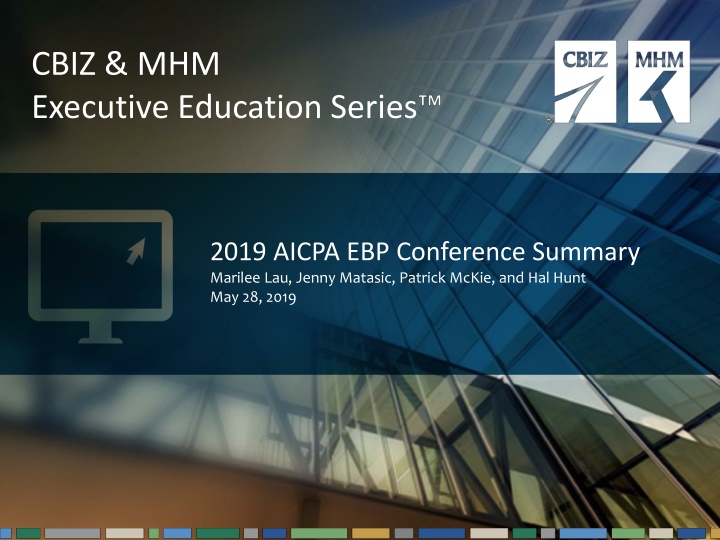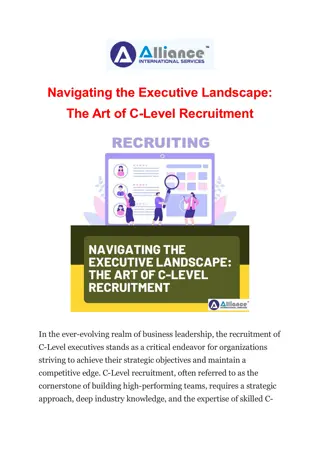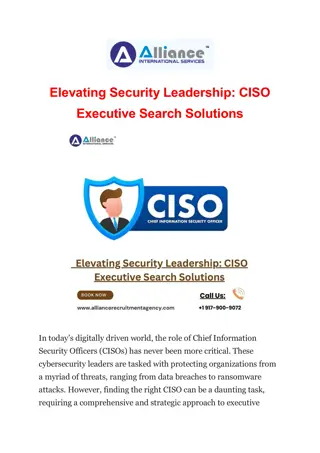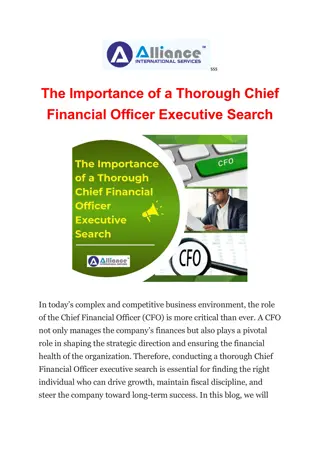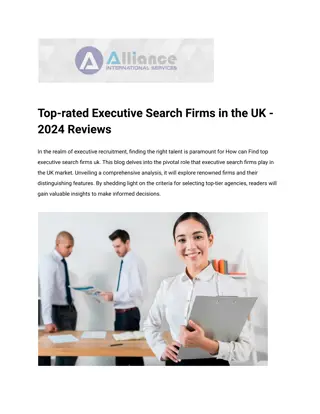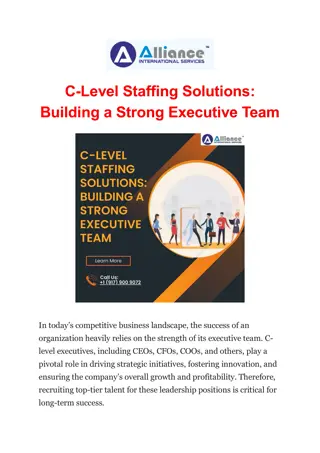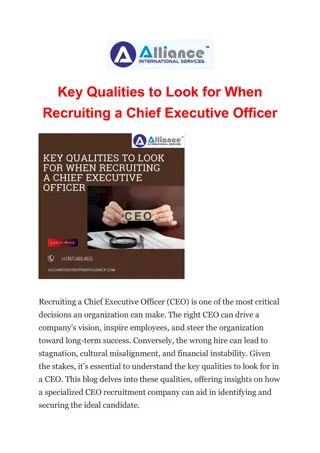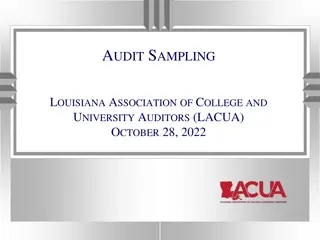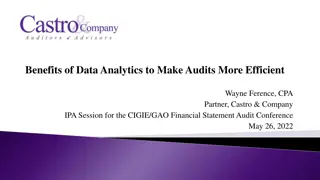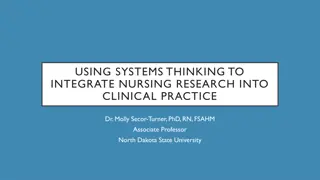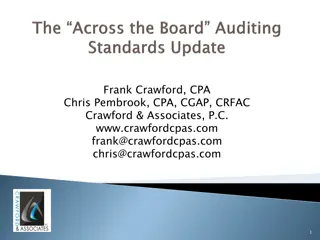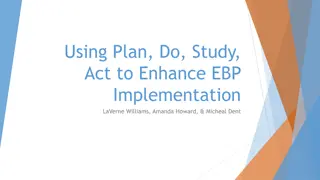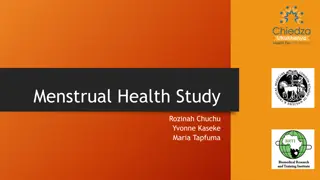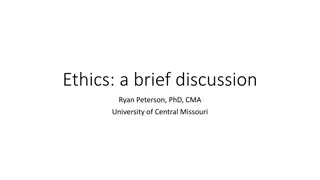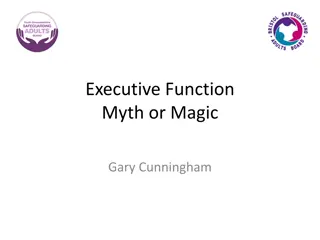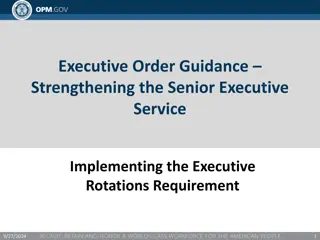CBIZ & MHM Executive Education Series 2019 AICPA EBP Conference Summary
In the Executive Education Series by CBIZ & MHM, key information from the 2019 AICPA EBP Conference is highlighted. The session covers aspects of tax, audit, attest, and advisory services provided by over 2,900 professionals nationwide. The webinar offers CPE credit and emphasizes the need for detailed discussions with service providers for personalized insights. Marilee Lau is among the expert presenters, offering consulting services and extensive experience in accounting and auditing for EBPs.
Download Presentation

Please find below an Image/Link to download the presentation.
The content on the website is provided AS IS for your information and personal use only. It may not be sold, licensed, or shared on other websites without obtaining consent from the author.If you encounter any issues during the download, it is possible that the publisher has removed the file from their server.
You are allowed to download the files provided on this website for personal or commercial use, subject to the condition that they are used lawfully. All files are the property of their respective owners.
The content on the website is provided AS IS for your information and personal use only. It may not be sold, licensed, or shared on other websites without obtaining consent from the author.
E N D
Presentation Transcript
CBIZ & MHM Executive Education Series 2019 AICPA EBP Conference Summary Marilee Lau, Jenny Matasic, Patrick McKie, and Hal Hunt May 28, 2019 1 Questions? Email cbizmhmwebinars@cbiz.com
About Us Together, CBIZ & MHM are a Top Ten accounting provider Offices in most major markets Tax, audit and attest and advisory services Over 2,900 professionals nationwide A member of Kreston International A global network of independent accounting firms MHM (Mayer Hoffman McCann P.C.) is an independent CPA firm that provides audit, review and attest services, and works closely with CBIZ, a business consulting, tax and financial services provider. CBIZ and MHM are members of Kreston International Limited, a global network of independent accounting firms. 2 Questions? Email cbizmhmwebinars@cbiz.com
Before We Get Started Use the control panel on the right side of your screen to: Change your audio mode Submit questions Download handouts If you need technical assistance: Call support at 877-582-7011 Email us at cbizmhmwebinars@cbiz.com 3 Questions? Email cbizmhmwebinars@cbiz.com
CPE Credit This webinar is eligible for CPE credit. To receive credit, you will need to answer polling questions throughout the webinar. External participants will receive their CPE certificates via email within 15 business days of the webinar. 4 Questions? Email cbizmhmwebinars@cbiz.com
Disclaimer The information in this Executive Education Series course is a brief summary and may not include all the details relevant to your situation. Please contact your service provider to further discuss the impact on your business. 5 Questions? Email cbizmhmwebinars@cbiz.com
Presenters Marilee provides consulting services and teaches various educational programs on accounting and auditing for EBPs. Before retiring in 2009, Marilee was the National Partner in Charge of KMPG s EBP Audit Practice. She is a founding member and former Chair of the AICPA EBPAQC Executive Committee established in 2004. Marilee was the 2011-2013 AICPA s representative to the DOL s ERISA Advisory Council. She has served on the AICPA s EBPs Experts Panel and chaired the EBP Audit Guide Overhaul Task Force including the new ESOP chapter. She is currently assisting the AICPA on writing the Multiemployer chapter for the Guide and is on the EBP Peer Review task force for EBP. She is also performing Peer Review Oversights as a subject matter expert. Marilee has served on the Advisory Board for the BNA Pension & Benefits Reporter and the Accountants Committee for the International Foundation of EBPs. Marilee P. Lau, CPA Retired Partner, KPMG, LLP She is a member of the AICPA, California Society of CPA s, and the International Foundation of EBPs and a frequent speaker for numerous professional conferences and programs. She is a graduate of Santa Clara University with a BS in economics and an M.B.A. in accounting. 415-706-6331 lau.marilee@gmail.com 6 CBIZ & MHM Questions? Email cbizmhmwebinars@cbiz.com
Presenters Jenny is a senior manager in the attest department. She has over ten years of experience in auditing employee benefit plans including defined contribution, defined benefit and health and welfare plans. She oversees the Tampa Bay office employee benefit plan practice. 727.572.1400 jmatasic@cbiz.com JENNY MATASIC, CPA Senior Manager, CBIZ MHM Tampa Bay 7 CBIZ & MHM Questions? Email cbizmhmwebinars@cbiz.com
Presenters Patrick has been working in the attest and accounting profession for many years, and has worked with a wide variety of clients ranging from international public companies to private start-up companies. He is responsible for the completion of many attest engagements throughout the year, and provides management and development of our dedicated attest personnel. Patrick also has significant experience in Employee Benefit Plan audits as well as the Construction, Real Estate, Not-for-Profit, Manufacturing and other industries. PATRICK MCKIE, CPA Senior Manager, CBIZ MHM Philadelphia 610.862.2329 pmckie@cbiz.com 8 CBIZ & MHM Questions? Email cbizmhmwebinars@cbiz.com
Presenters Hal leads the Employee Benefit Plan Audit Practice. With over 30 years of diverse experience with EBP accounting, auditing and compliance issues, he is also a member of the firm s Professional Standards Group as a subject matter expert on EBP plan audits, as well as business combinations and lease accounting. As the National Practice Leader for EBP Audits, Hal is responsible for providing internal training on the subject, along with providing technical support to engagement teams, serving as engagement quality reviewer and developing resource tools for our EBP audit professionals. In addition, Hal has served on the AICPA's Employee Benefit Plan Audit Quality Center (EBPAQC) Executive Committee and is also a member of the AICPA's EBPAQC ESOP Task Force and Practice Monitoring Task Force. HAL HUNT, CPA Shareholder 816.945.5610 hhunt@cbiz.com 9 CBIZ & MHM Questions? Email cbizmhmwebinars@cbiz.com
Agenda 01 Accounting and Auditing Update & New Reporting Standard Changes in Participant Loans and Hardship Withdrawals 02 DOL & IRS Examinations Areas of Focus 03 Changes to EPCRS Rev. Proc. 2019-19 04 05 DOL Findings in Inspections Risk Assessment 06 Use of a SOC 1 Report 07 10 CBIZ & MHM Questions? Email cbizmhmwebinars@cbiz.com
Accounting Update 11 CBIZ & MHM Questions? Email cbizmhmwebinars@cbiz.com
No new accounting standards effective for 2018 plan year ends Early adoption is permitted for: ASU 2017-06 Employee Benefit Plan Master Trust Reporting ASU 2018-09 Codification Improvements ASU 2018-13 Changes to the Disclosure Requirements for Fair Value Measurements Accounting and reporting Actuarial Improvement Scale On the horizon 12
ASU 2017 ASU 2017- -06: EBP master trust reporting 06: EBP master trust reporting Issued February 2017 Effective for fiscal years beginning after December 15, 2018. Early adoption permitted. Retrospective application. A plan s interest in each master trust and any change in that interest is presented in separate line items in the financial statements. Removes the requirement to disclose the percentage interest in the master trust for plans with divided interests and requires that all plans disclose the dollar amount of their interest in each of those general types of investments, which supplements the existing requirement to disclose the master trust s balances in each general type of investments. Requires all plans to disclose (1) their master trust s other asset and liability balances and (2) the dollar amount of the plan s interest in each of those balances. Must adopt the master trust amendments and the 401(h) amendments at the same time, if both are applicable. 13
What is a Master Trust? A trust for which a regulated financial institution serves as a trustee or custodian and in which assets of more than one plan sponsored by a single employer or by a group of employers under common control are held. Used to defray administrative and investment costs for such plans. Can be held as an undivided interest (DB plans) or a divided interest (DC plans) Background 14
Illustration for divided interest in master trust Illustration for divided interest in master trust 15 15
Illustration for undivided interest in master trust Illustration for undivided interest in master trust 16 16
ASU 2017-06 - Observations Same presentation for plans with divided and undivided interests. Other investment-related disclosures continue. ASU does not specifically address disclosures for fair value (ASC 820), derivatives and seller of credit derivatives (ASC 815), offsetting (ASC 210), securities lending, repurchase agreements and short sales (ASC 860), but the ASU s Basis for Conclusions explains that existing interpretative guidance is sufficient (e.g., AICPA Technical Practice Aid TIS Section 6930.11 and Audit Guide), so those disclosure requirements continue. MASTER TRUST REPORTING 17
ASU 2017-06 - Observations A full Statement of Changes in Master Trust Net Assets is not required, although disclosures for net appreciation and other investment income (e.g., dividends and interest) is required. MASTER TRUST REPORTING Investmentincome: Net appreciation (depreciation) $xxx,xxx Dividends Interest xxx,xxx xxx,xxx Net appreciation no longer needs to be broken out by general type of investment; it can be a single amount. 18
Postretirement medical-benefit obligations may sometimes be funded through a health benefit account (401(h) account) in a defined benefit plan. 401(h) account net assets are used to provide medical benefits thorough a H&W plan and are represented on the face of the DB plan s financial statements as an asset with an offsetting liability 401(h) Account Investment Disclosures ASU 2017-06 concluded that H&W plans are not required to include investment disclosures related to the 401(h) account but requires the H&W plan to disclose the name of the DB plan in which the investment disclosures are provided. 19
Amends the illustrative example in Subtopic 962-325 to remove the stable value common collective trust fund previously illustrated as net asset value per share practical expedient to avoid the interpretation that the such an investment would never have a readily determinable fair value. Clarifies that an entity should evaluate whether a readily determinable fair value exists or whether its investments qualify for the net asset value per share practical expedient. ASU 2018-09 Codification Improvements Issued July 2018 Moved property, plant and equipment guidance from Subtopic 962-205 to 962-360. Replaces indefinite deferral guidance that was in paragraph 820-10-65-9 with a disclosure exemption in paragraph 820-10-50-2(bbb)(2). Effective for fiscal years beginning after December 15, 2018 (public business entities) and after December 15, 2019 (all others). Early adoption is permitted Prospective application 20
It modifies the disclosure requirements in ASC Topic 820, Fair Value Measurement. Eliminates, amends and adds disclosure requirements. ASU 2018-13 Changes to the Disclosure Requirements for Fair Value Measurement The proposal applies to all entities that are required under existing US GAAP to disclose recurring or nonrecurring fair value measurements. The ASU is effective for all entities for all reporting periods (annual and interim) beginning after December 15, 2019. Early adoption is allowed. An entity may elect to early adopt only the eliminated or modified disclosure requirements. 21
The amount of and reasons for transfers between Level 1 and Level 2. The policy of timing of transfers between the various Levels. ASU 2018-13 Eliminated disclosures The valuation policies and procedures for Level 3 measurements. For nonpublic entities, the changes in unrealized gains and losses for the period included in earnings for recurring Level 3 fair value measurements. 22 22
Level 3 rollforward nonpublic companies should disclose purchases/sales and transfers into and out of Level 3 instead of rollforward. For investments in certain companies that calculate net asset value, the timing of liquidation of investee s assets, and the date when restrictions from redemption might lapse need to be disclosed only if known. ASU 2018-13 Amended disclosures Measurement uncertainty communicates information about the uncertainty in measurement as of the reporting date. The term at a minimum is removed from the disclosure requirements to make it clear that materiality and discretion are appropriate considerations. 23 23
Changes in unrealized gains and losses included in other comprehensive income for recurring Level 3 fair value measurements. ASU 2018-13 New disclosures Disclose additional supporting information used to derive significant unobservable inputs for fair value measurements under Level 3 (range and weighted average, median and arithmetic average, as appropriate). Not applicable to nonpublic entities 24
Mortality Improvement Scales (MP- 2018) Issued October 2018 Society of Actuaries (SOA) issued MP-2018 improvement scale on October 23, 2018 Incorporates mortality data from the Social Security Administration, which indicates that deaths are occurring at rates slightly higher than assumed in 2018 mortality improvement scale (MP-2018) Reflects a decrease in the rate of improvements in life expectancies in the United States compared with the data in the MP-2018 SOA did not update the RP-2014 base mortality tables Updated information should be considered for 2018 audits and any 2017 audits issued after October 23, 2018 Will be updated again October 2019 Technical Question and Answer (TIS 3700.01) 25
Multi-employer chapter to Audit & Accounting Guide ASC 606, Revenue from Contracts with Customers (Rev Rec) ASC 842, Leases ASU 2016-13, Measurement of Credit Losses on Financial Instruments ASU 2018-14, Changes to the Disclosure Requirements for Defined Benefit Plans - Amends ASC 715-20 On the horizon
AUDITINGUPDATE 27 Questions? Email cbizmhmwebinars@cbiz.com
2019 EBP Audit and Accounting Guide revisions Effective ASUs No new ASB auditing standards effective for 2018 plan year audits No new PCAOB auditing standards effective for 2018 plan year Form 11-k audits Auditing update EBP Audit Risk Alert Risk Assessment On the horizon New EBP Audit Standard (the ASB-approved EBP SAS is available on the AICPA's website) 28
Forming an opinion and reporting on financial statements of employee benefit plans subject to ERISA (EBP SAS) AICPA Auditing Standards Board (ASB) voted the EBP SAS final in July 2018 Prescribes certain new performance requirements for an audit of financial statements of employee benefit plans subject to the Employee Retirement Income Security Act of 1974 (ERISA) Changes the form and content of the related auditor's report. Pending conforming changes for proposed auditor reporting standards and related amendments (first half of 2019) EBP SAS expected to be issued first half of 2019 When issued to be effective no earlier than periods ending on or after December 15, 2020. Early adoption is not permitted 30 30
January 2015 - ASB formed a special task force to consider the auditor reporting model for audits of ERISA plan financial statements tasked with finding ways to improve the communicative value and relevance of the auditor s report Improve the quality of EBP audits Exposure Draft was issued in April 2017 with 9 Issues for Consideration Received 108 comment letters from auditors, state societies, state auditors, preparers, and attorneys ED was revised based upon comments and ASB voted the EBP SAS final in July 2018, pending conforming amendments for the auditor reporting project Prescribes certain new performance requirements for an audit of financial statements of EB plans subject to the ERISA Changes the form and content of the related auditor's report. Background Conforming amendments for auditor reporting standards (voted final in January 2019) expected to be approved as final at the May 2019 ASB meeting Effective for audits of ERISA plan financial statements for periods ending on or after December 15, 2020. Early adoption is not permitted 31
The final ballot draft of the EBP SAS is posted on AICPA website, pending conforming amendments for new auditor reporting standard (to be approved as final in May 2019) Final Ballot Draft of EBP SAS Will be new section AU-C 703, Forming and Opinion and Reporting on Financial Statements of Employee Benefit Plans Subject to ERISA Applies in place of AU-C section 700 Paragraph .09 of AU-C 725 Amends various AU-C sections 32
Performance Requirements 33
In addition to preconditions in AU-C 210, management should acknowledge its responsibility for: Maintaining a current plan instrument, including amendments Administering the plan and determining plan s transactions are in conformity with plan provisions Maintaining sufficient records for each participant to determine benefits when due Engagement Acceptance 34
For ERISA Section 103(a)(3)(C) Audits, determining whether ERISA section 103(a)(3)(C) audit is permissible under the circumstances The investment information is prepared and certified by a qualified institution (29 CFR 2520-103-8) The certification meets the requirements of 29 CFR 2520-103-5 The certified investment information is appropriately measured, presented, and disclosed in accordance with the applicable financial reporting framework Engagement Acceptance (continued) The auditor is required to inquire of management about how management determined that the entity preparing and certifying the investment information is a qualified institution Obtain the agreement of management to provide to the auditor, prior to the dating of the auditor s report, a draft of Form 5500 that is substantially complete 35
Because of the nature of an EBP audit, it would be rare for the auditor, based upon risk assessment, not to test any relevant plan provisions Audit Risk Assessment and Response Obtain and read the most current plan instrument, including effective amendments as part of gaining an understanding sufficient to perform risk assessment procedures Consider relevant plan provisions that affect the risk of material misstatement at the relevant assertion level when designing and performing audit procedures Appendix A in the EBP SAS provides some examples of plan provisions 36
Prohibited Transactions. Evaluate whether prohibited transactions identified by management or as part of the audit have been appropriately reported in the applicable ERISA- required schedule Audit Risk Assessment and Response (con t) Plan Tax Status. In accordance with AU-C 250, consider whether management has performed the relevant IRC compliance tests, including, but not limited to, discrimination testing, and has corrected or intends to correct failures 37
Evaluation and Documentation. Audit Risk Assessment and Response (con t) When work performed results in identification of items that are not in accordance with the criteria specified (plan provisions) evaluate whether they are reportable findings 38
Communication With Those Charged With Governance (TCWG). Communicate reportable findings in writing, on a timely basis Included with the required communications in accordance with 250, 260, or 265 Communication should include: Description of reportable finding Sufficient information to enable TCWG and management to understand the context An explanation of the potential effects on the financial statements or to the plan Communication With TCWG 39
When performing an ERISA section 103(a)(3)(C) Audit, the auditor is required to: ERISA Section 103(a)(3)(C) Requirements Evaluate management s assessment of whether the entity issuing the certification is a qualified institution Identify which investment information is certified 40
Perform the following procedures on the certified investment information: Obtain and read certification Compare certified investment information with related information presented and disclosed in the financial statements and supplemental schedules Read the disclosures relating to the certified investment information to assess whether they are in accordance with the presentation and disclosure requirements of the applicable financial reporting framework ERISA Section 103(a)(3)(C) Requirements (con t) 41
ERISA Section 103(a)(3)(C) Requirements (con t) For all audits, perform procedures necessary to become satisfied that received and disbursed amounts reported by the trustee or custodian were determined in accordance with the plan provisions. Perform audit procedures on the financial statement information, including disclosures, not covered by the certification as well as non-investment related information 42
In addition to AU-C 580 requirements, request the following written representations from management: That management has provided the most current plan instrument, including plan amendments Written Representations Acknowledge its responsibilities for administering the plan and determining that the plan s transactions that are presented and disclosed in the ERISA plan financial statements are in conformity with the plan s provisions, including maintaining sufficient records of each participant 43
For ERISA Section 103(a)(3)(C) Audit: Acknowledgment that management s election does not affect its responsibility for the financial statements or for determining whether: An ERISA section 103(a)(3)(C) audit is permissible The investment information is prepared and certified by a qualified institution The certification meets the requirement of 20 CFR 2520.103-5 The certified investment information is appropriately measured, presented, and disclosed in accordance with the applicable financial reporting framework. Written Representations (con t) 44
Related to the ERISA-Required Supplemental Schedules Acknowledges its responsibility for the presentation of the ERISA-required supplemental schedules in accordance with DOL Rules and Regulations That it believes the ERISA-required supplemental schedules, including their form and content, are presented in conformity with the DOL Rules and Regulations Written Representations (con t) 45
The EBP SAS also covers: Forming an Opinion Form of Opinion (unmodified clean ; modified) Other Key Areas Considerations relating to the Form 5500 Comparative financial statements 46
ERISA-required supplemental schedules Non 103(a)(3)(C) follows AU-C 725 with some additional content 103(a)(3)(C) requires Other Matter paragraph and the following procedures to be performed: Determine whether the form and content of the ERISA- required supplemental schedules, other than certified information, is presented in conformity with DOL rules and regs Compare and reconcile information, other than certified information, to underlying accounting and other records Obtain written representations ERISA Required Supplemental Schedules 47
SAS No.134 48
Statement on Auditing Standards (SAS) No. 134, Auditor Reporting and Amendments, Including Amendments Addressing Disclosures in the Audit of Financial Statements New section AU-C 701, Communicating Key Audit Matters in the Independent Auditor s Report Auditor Reporting AU-C 700 Series Supersedes: AU-C 700, Forming an Opinion and Reporting on Financial Statements; AU-C 705, Modifications to the Opinion in the Independent Auditor s Report; AU-C 706, Emphasis-of-Matter Paragraphs and Other-Matter Paragraphs in the Independent Auditor s Report Amends various AU-C sections Effective for audits of financial statements for periods ending on or after December 15, 2020. Early implementation is not permitted. 49
Forming an Opinion and Reporting on Financial Statements (section 700) Changes the form and content for all auditor s reports issued for audits of non-issuers (except for employee benefit plans) Consistent with the changes to the auditor s report resulting from the IAASB s new and revised ISAs Consistent with the new PCAOB auditor reporting model with respect to the positioning of the opinion and the basis for opinion sections. EBP SAS conformed to SAS 134 50
